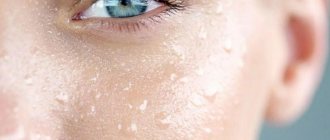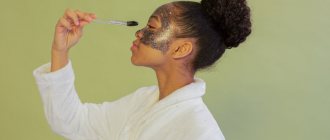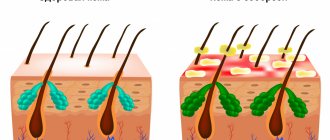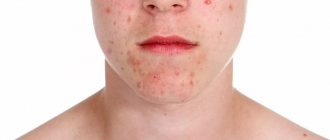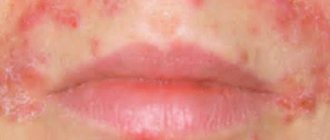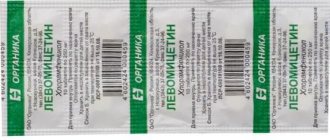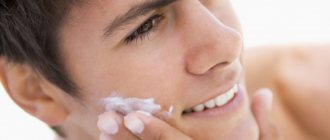This is not only an external imperfection, but also a signal of a disruption in the functioning of internal organs. Each part of the face is responsible for specific organs and their systems. An experienced therapist, looking at a patient, can easily determine what is wrong with his health.
The skin of the face carries information about the condition of the entire body, and the map of acne on the face is a direct reflection of the internal organs. This is what traditional Chinese medicine says.
The rash map looks like this:
- forehead, temples and bridge of the nose,
- nose area,
- cheeks,
- area around the lips,
- chin and neck.
Pimples and oily skin on the forehead. Causes of acne on the forehead in women
Let's find out what causes acne on the forehead of women.
- Harmful cosmetics
They can be caused by certain cosmetics or hair products, such as shampoos, sprays or hair gels, that contain harmful chemicals and too much oil. They get on the skin of the forehead and provoke acne.
- Clogged pores
This is one of the main factors causing skin rashes. Excess skin oil often forms on the forehead. This is why clogged pores occur here. Therefore, it is important to take care of your skin and cleanse it daily.
Dandruff is one of the most common causes of acne on the forehead. Women with oily scalp are also prone to their appearance.
- Hormones
Most often, acne in this area of the face is the result of hormonal changes during puberty, and at an older age, after 35-40 years, their occurrence can be triggered by hormonal imbalance. In addition, this hormonal imbalance can also occur during pregnancy, as well as due to certain birth control pills, which stimulate acne inflammation.
- Medicines
The appearance of acne in these places is often caused by taking medications, such as vitamins and antibiotics in large quantities. These medications can have a negative effect on other internal organs, causing increased activity of the sebaceous glands, which begin to rapidly produce subcutaneous fat.
- Habit of touching your face
Some girls and women have the bad habit of constantly touching their face with their hands, and especially their forehead. Bacteria from the hands get onto the skin, contaminate the pores and cause inflammation.
- Excessive skin cleansing
Exfoliation is great for ridding your skin of dead cells and leaving it looking fresh. However, if you do this procedure often, it can cause irritation and cause acne. In addition, excessive cleansing of the skin and frequent washing can also lead to their appearance. Its reaction will be an increase in sebum production.
- Stress
When stressed, the body produces a hormone called androgen. This hormone is known to cause more sebum to be produced. This sebum leads to increased oiliness on the face.
- Bad habits
Poor nutrition, excessive consumption of salty, smoked, pickled foods, and dishes with a high content of spices can also cause skin rashes. Wrong lifestyle and bad habits are the main enemy of skin health.
Treatment of acne on the forehead: what to do if you have acne?
The appearance of even one or two elements of acne on the forehead can be very frustrating and spoil the appearance. If we are not talking about an accidental pimple before menstruation or one that appeared in winter due to rubbing with a hat, you need to seriously think about treatment. You need to get rid of rashes correctly:
- Contact your doctor. It is necessary to visit a dermatologist and undergo tests that will help determine the cause of acne. You may also need to consult a gastroenterologist, gynecologist, or endocrinologist. Some girls prefer to get rid of rashes in a cosmetologist's office. This is not a mistake, since specialists in aesthetic medicine must have qualifications in the specialty “Dermatovenereology.”96 In addition, some cosmetic procedures (laser, ozone, plasma therapy, microcurrents, etc.) can help improve the condition of the skin. But in severe forms of acne, the patient is still referred to a dermatologist.
- Forget about squeezing out acne. No matter how bad the rash looks, you need to gather your courage and remove your hands from your face. Squeezing pimples can lead to skin injury and subsequent scar formation, infection in the wound, and an increase in the number of acne elements.
- Explore your makeup bag. Often acne appears due to incorrectly selected cosmetics. If you use products that clog pores or those that have expired, then the cause of acne is obvious.
- Pay attention to hygiene. Wash your makeup brushes, change your pillowcase once a week, and prefer paper towels when wiping your face.
- Take proper care of your skin. Remove makeup with micellar water or hydrophilic oil (if you used waterproof cosmetics). Wash your face using special gels, mousses, foams, not soap. Treat your face with toner. Don't neglect moisturizing your skin.
It's oily skin. Causes of oily skin
— Hormones affect the production of oil in the sebaceous glands: In the second phase of the menstrual cycle, women experience an increased amount of sebum secreted. This is due to hormonal levels. Oily skin is more common in men, regardless of age. This is due to the predominance of the hormone testosterone in the body, which is responsible for the production of sebum. The problem of excessive oily skin often occurs in young women, girls, teenagers, especially over 12 years of age. This problem occurs due to puberty. It is characterized by excessive activity of the sebaceous glands.
— Environmental factors, stress (especially chronic stress), cigarette smoke, air pollution influence.
- UV aggravates problems with oily skin. The sun's rays dry out and thicken the stratum corneum, which prevents the release of sebum and acne (pimples, blackheads) appears.
— Poor nutrition, eating large amounts of fried, fatty, spicy food increases the greasiness of the skin.
— Lack of hygiene (regular washing in the morning, treatment of skin areas prone to oiliness) leads to increased oiliness and inflammation of the skin.
— An increase in ambient temperature increases the secretion of sebum.
- The amount of sebum secreted also depends on the area of the body. The largest number of sebaceous glands are located on the face, chest and torso. — The use of low-quality cosmetics that are oily or greasy aggravate skin problems.
— Immune system disorders contribute to oiliness, since the skin is a protective layer. If immune processes are disrupted, a symptom of increased oily skin may appear.
Pimples on the head: why they appear, and is it possible to get rid of the rashes
Despite the fact that formations under the hair can be hidden from the eyes of others with a stylish hairstyle or a fashionable headdress, acne on the head causes a lot of trouble for their owners, associated primarily with itching and painful sensations when scratching.
In addition, it is impossible to see a comedon or papule - the condition of a pimple must be assessed by touch, and this also causes a certain psychological discomfort. The described problem is not always cosmetic and may indicate the presence of quite serious diseases in the body.
For this problem, we recommend contacting our Private Practice clinic, where highly competent dermatologists will determine the cause of the rash and prescribe the correct course of treatment. You can make an appointment at a convenient time: we are open 7 days a week from 09:00 to 21:00.
Internal and external causes of acne on the head
The patient himself can provoke the growth of rashes. Specialists at our clinic consider such reasons to be external. A dermatologist usually works with them. Often the following actions of patients lead to the appearance of acne in the hair:
- insufficient head hygiene - infrequent washing provokes blockage of the sebaceous glands, and shaving with dull trimmers and razors causes irritation of the skin, on which rashes may appear;
- hypothermia - in this case, acne first appears on the back of the head and temples, as the most unprotected areas, and also with thin skin;
- improper selection and use of cosmetics - shampoos that dry out the skin, too frequent dyeing with aggressive coloring compounds disrupt the water-fat balance of the epidermis of the head, creating an ideal environment for the appearance of acne. This also includes regular blow-drying and washing your hair with excessively chlorinated water;
- wearing hats made of synthetic fabric for a long time - the skin sweats in them, the ducts become clogged, and the sebaceous glands begin to actively secrete secretions, after which the appearance of purulent acne on the head is only a matter of time;
- taking steroid drugs.
Internal causes are more serious. In this case, acne on the head may indicate:
- hormonal disorders. Particularly often, as a result of hormonal imbalance, acne occurs on the scalp in premenopausal women, during pregnancy and with polycystic ovary syndrome, as well as in adolescents during the period of the so-called hormonal storm. In men, such symptoms may indicate a malfunction of the adrenal glands;
- incorrect functioning of the gastrointestinal tract: for example, acne in the temple area indicates that it is time to check the liver and gallbladder, and rashes in the back of the head indicate abnormalities in the intestinal microflora;
- weakened immunity, in which entire colonies of staphylococci and streptococci are found in the patient’s body during tests in the laboratory of our medical center;
- chronic stress;
- diseases acquired through sexual contact.
In addition, the appearance of formations in the scalp can be caused by poor nutrition with excess consumption of processed fats and simple carbohydrates.
Diagnosis and treatment
In our Private Practice clinic, specialists always use comprehensive treatment for acne in the hair, aimed not only at ridding the patient of external manifestations, but also at eliminating internal causes. In order to identify them, first of all, a comprehensive study is prescribed, which includes:
- blood tests - general, biochemical formula and certain types of hormones;
- scrapings from the scalp;
- stool analysis to study the state of intestinal microflora;
- if necessary, ultrasound of internal organs;
- studies to exclude the presence of STDs.
Only after determining the cause of acne, the clinic’s specialized specialists - a dermatologist, venereologist, endocrinologist and others - get down to business, jointly developing treatment tactics with both external means and drugs for internal use.
If you regularly have rashes on your head, this is a “signal” from the body that something is wrong. Don’t let the disease get worse, consult a doctor on time and be healthy!
You can make an appointment with a doctor by calling
+7+7 (495) 980-13-16
Oily facial skin. Pros and cons of oily skin
Any person raises his own self-esteem through appearance.
Leather plays one of the key roles in this matter. It is a kind of “atlas” of human internal diseases and a business card at the same time. Because of this, it is important that she is always healthy and has a pleasant appearance. Oily skin requires more painstaking care compared to other skin types, however, it has a significant advantage. Its owners acquire wrinkles much later, especially age-related ones. And its care does not require constant replenishment of creams. It constantly secretes sebum in copious amounts, which keeps it moisturized.
Peculiarities
Oily skin is a definition of one of the four human skin types. This type is the easiest to identify, due to the specific shine from the rapid production of sebum from the glands. Often we are talking about the face, but the chest or back may also have increased fat content.
This skin type is not a disease. This is a type of norm. Along with dry, normal and combined (mixed) types. It usually changes with age. Thus, the fatty type often becomes combined. Also, continuous use of cosmetics can mislead you about the true condition of your skin. The fatty type is more susceptible to the manifestation of dermatological diseases.
Oily skin is most common among teenagers and young adults. By the age of thirty, the problem is most often solved by changing the skin type. Less than 10% of people retain it into adulthood.
Causes
- There is no way to change this. Only well-chosen daily care and cosmetics can bring maximum results.
- The most vulnerable in this regard are the thyroid and pancreas glands, the gastrointestinal tract, especially the intestines. Constant stress has a detrimental effect on the skin. In this case, the solution will be to eliminate the cause and provide easier care.
- The problem arises only in adolescence during the restructuring of the hormonal system. Most often, in this case, the skin returns to normal by the age of twenty-five. Read what to do if men have oily facial skin.
- Junk food, sweets and fatty foods negatively affect the functioning of the gastrointestinal tract. And, as a result, the skin suffers. To solve it, you just need to switch to proper nutrition.
- They are necessary in the treatment of problem skin, but should not be used on an ongoing basis. This will only have the opposite effect. Read more about using gentle methods.
- It should also be used in moderation. With frequent use, the skin suffers and sebum production increases.
Pimples on cheeks
Persistent pimples on both cheeks combined with red capillaries may be a sign of lung problems. If the respiratory system is in order, a rash on the cheeks may indicate an oversaturation of proteins. Imperfections in this area also occur with excessive consumption of coffee and carbohydrates.
If there are more acne on the right cheek, this may indicate:
- imbalance in the gastrointestinal tract,
- excessive consumption of sweets,
- food allergies,
- problems with the respiratory system.
Possible causes of rashes on the left cheek include:
- stomach and liver diseases,
- binge eating,
- chronic stress.
Oily facial skin folk remedies. Products for skin tone with oily face
Every morning you need to start by washing with special tonics; for this you can buy professional products, or prepare them yourself. In particular, a solution of water and salicylic alcohol helps very well for very oily skin. Take a tablespoon of liquid per glass of water. This lotion will degrease the skin and temporarily eliminate oily shine.
A decoction of green tea also cleanses the dermis quite well. Just brew the drink without mixing it with sugar, and wash your face as often as possible. If desired, you can also add tea tree oil to the tea leaves (literally 5-7 drops). This folk remedy also helps reduce the oiliness of the dermis.
Sensitive oily skin requires special care; alcohol methods should not be used here. Very gentle folk remedies are needed - milk, cucumber water and aloe infusion. The method for preparing cucumber lotion is similar: add either one sliced cucumber or 3-5 sprigs of aloe to a glass of boiled water. Let it sit overnight and wipe your face with the resulting liquid in the morning.
Don't forget about the miraculous properties of honey. This product helps with very oily skin with a variety of problems. Take two tablespoons of the sweet ingredient for a glass of warm water. Wipe the dermis with the resulting product three times a day.
Cryotherapy has proven itself to be simply excellent for giving skin tone, especially in summer. Ice massage in the morning is a procedure that will help prolong youth, get rid of wrinkles, and cleanse the skin of acne and pimples. The main thing is to massage your face not with a simple ice cube, but with a frozen decoction of medicinal herbs.
How to treat acne on the forehead using Azelik® gel?
The dream of clear skin can be achieved if you approach acne treatment correctly. It should be prescribed by a dermatologist. For mild to moderate acne, the doctor may recommend the use of azelaic acid, for example, Azelik®5,9 gel.
The drug must be used twice a day, applied to previously cleansed, dry skin5. The first results from using the drug usually become noticeable after a few weeks5.
*acne
Oily skin signs. Oily skin
Oily skin will not cause any special problems if you take care of it correctly and regularly. Moreover, with proper care, oily skin retains a youthful and fresh appearance much longer than dry skin. In people with oily skin, it begins to appear later. However, in youth, during the period of hormonal changes in the body, oily skin is often manifested by a pronounced greasy sheen, enlarged pores, and comedones and pustular elements may appear on it. Often, not only the skin of the face, but also the head, chest, and back are characterized by increased oiliness. Approximately 10% of people with oily skin continue to have such problems after the age of 30.
Oily skin is one of four variants of the norm (normal and combination skin are also possible). If the oily skin becomes pathological, it is seborrhea (when not only the production of sebum is increased, but its qualitative composition is also changed: the content of unsaturated fatty acids is insufficient, its bactericidal properties are reduced). If pustular rashes regularly appear against the background of seborrhea, this is already.
Oily skin and hormonal levels
Oily skin is characterized by increased activity of the sebaceous glands, which is largely regulated by sex hormones. This is due to the fact that in youth, during the period of highest levels of sex hormones, the skin is oilier. As you age, both hormone levels and skin oiliness decrease. The sebaceous glands react to changes in hormonal levels in all people, but the degree of their sensitivity varies from person to person and is determined genetically. Therefore, with the same level of hormones, different people will have different skin oiliness.
Women may experience pronounced changes in skin oiliness depending on the phase of the menstrual cycle during pregnancy.
Comedones
One of the problems typical for oily skin is the appearance of comedones. These can be “black dots” that clog the ducts of the sebaceous glands - black comedones (open comedones). And “white pimples”, unlike pustular elements, are not accompanied by inflammatory phenomena (redness) - these are white comedones (closed comedones, milia).
Comedones occur due to blockage of the sebaceous gland duct. It is generally accepted that the color of black comedones is due to “dirt” that has entered it from the outside. This is not true; dust and other external pollutants do not play an important role in this. The black color is given to it by the products of oxidation of sebum fats and the remains of cells contained in it, exfoliated from the walls of the sebaceous gland duct, containing a dark pigment - melanin. The color of a white comedon is determined by the color of the sebum contained in it. Since in this case it does not have contact with air oxygen, it does not oxidize and retains its light color.
Beauty treatments for oily skin
To suppress the activity of the sebaceous glands, cleanse and narrow skin pores, and smooth the skin, cosmetologists use various effects:
- Ultrasonic facial cleansing (ultrasonic peeling) effectively cleanses the skin of various types of impurities and smoothes the stratum corneum of the epidermis. Ultrasonic peeling affects only the stratum corneum of the skin, its effect is gentle and non-traumatic.
- Superficial chemical peeling allows you to make the rough superficial stratum corneum of the skin thinner, remove the gray tint it gives to the skin, tighten pores and restore a fresh appearance to the skin.
- Medium peels (Pro Anthox, Yellow peel) remove the stratum corneum completely and affect the deeper layers of the epidermis. The use of medium peels allows you to remove pigment spots and scars (often left after acne), even out skin texture, and eliminate fine wrinkles.
- Beautytek Premium biocybernetic therapy allows you to normalize the function of the sebaceous glands, improve local metabolism, activate the removal of harmful substances from the skin and accelerate its recovery processes.
- LPG facial massage helps to cope with swelling and improves blood supply to the skin.
- Biorevitalization. Oily skin may suffer from dehydration. Of course, this problem is less typical for it than for dry skin, but oily, dehydrated facial skin is not so rare. Carrying out injection and laser biorevitalization procedures allows us to successfully solve it.
- Mesotherapy allows you to deliver vitamins, microelements and medicinal substances directly to the problem area.
- Natura Bisse and Dermalogica cosmetic procedures using lines for oily skin provide comprehensive individual care.
Effective treatments for acne and pimples
NeoGen procedure
Plasma therapy
Peeling
Phototherapy
Face cleaning
Placental therapy
Many people think that acne on the face is the fate of unhappy teenagers. But there are rashes on the face in older people too. Let's figure out what it could be and how to deal with it.
